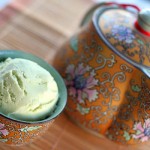
Come into my store.
The spice-sellers in Marrakech’s mellah are charming — less pushy than the aggressive salesmen around touristy Djmaa el-Fnaa plaza, but clever salesmen nonetheless. Their goods are enticing, and if you linger too long over a mysterious brown twig or white powder, you’ll find yourself getting a whole explanation of every spice and perfume that store has to offer. Don’t worry, you don’t have to buy anything. But here’s a little gift for you — a bunch of fennel flowers for cleaning the teeth, or a ceramic disc full of henna lipstick. No problem, go walk around the market. Just remember us if you want to buy something.
And it works. They know the gift makes tourists feel obligated, and after two very pleasant chats with two very pleasant shopkeepers, we found ourselves avoiding eye contact and racing past entreats. Because there’s just so many spices a person can buy.

(A spice seller in the Mellah. In the top photo: Rows of perfumes and incense in the front, spice towers in the back.)
One particularly pleasant man, Tawfik, shared his philosophy as well as his spices — the sellers at Djmaa el-Fnaa jack up prices, but here in the mellah, the former Jewish quarter, the vendors are fair. He believes there should be one price for both Moroccans and tourists, he told us. Because if you like him, you’ll come back. And indeed, his prices seemed more than reasonable — ground spices for 40 to 70 dirhams that would have cost 40 to 70 shekels at home (a 60% discount), very aromatic saffron at 20 dirhams a gram (here it’s 18 shekels), and tea and spice blends for half what they cost at the Carmel Market.
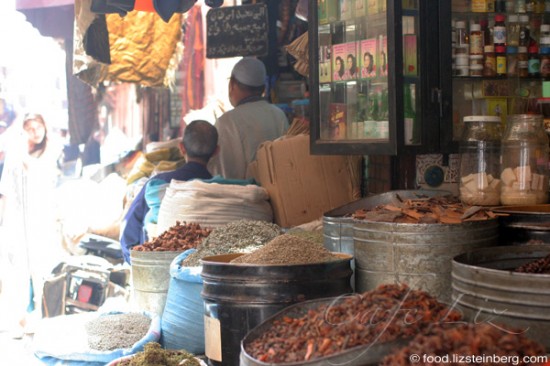
I don’t know when I’ll ever see Tawfik again, but I did indeed buy a ginseng herbal tea blend that we’d had in Djmaa el-Fnaa a few nights earlier, as well as his 35-spice ras el-hanut, because how could I not?

Generally speaking, ras el-hanut is made from a handful of commonly used spices — basically baharat plus cumin and coriander — but the spice-sellers in the mellah seem to compete in terms of complexity and mystery. I bought my spices unground, so that I could pick through them to unlock their secrets once home, but ultimately I only figured out about half of the components.
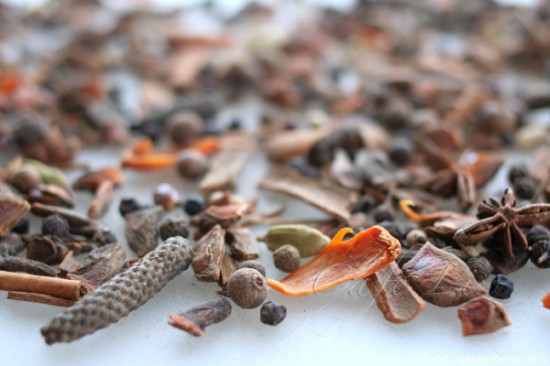
Thirty-five spices or not, Tawfik’s ras el-hanut (above photo) has a handful of dominant players, namely star anise, mace, cardamom, cinnamon, allspice, pepper, Aleppo pepper, nutmeg, cloves and juniper. The other 25 or so spices appear less frequently, which means that a mix of those first 10 would probably be a close approximation of the flavor — one I’d be content with.
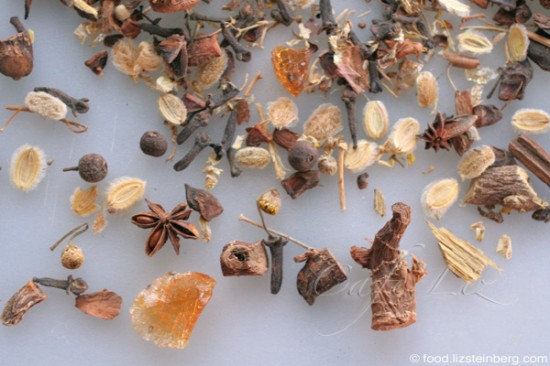
And the ginseng tea (above photo) has proved to be quite the mystery as well — there are nearly no references online to Moroccan ginseng tea. Has no one else been to Djmaa el-Fnaa and fallen in love with the stuff? Was this tea a figment of my imagination? (No, I certainly have a large bag of it.) I would have written this off as Tawfik’s creation had the tea not been so ubiquitous around Marrakech.
Anyway, the tea’s strongest taste components are ginseng root and licorice root, if you wanted to make it, it would go something like this:
- ginseng root
- licorice root
- star anise
- anise seeds
- cinnamon (cassia)
- cloves
- allspice
- cardamom
- peppercorns
- fuzzy cumin pods (I’d substitute cumin seeds, since that’s what I have)
- gum arabic
- a few things I can’t identify — a rather flavorless flower that looks like chamomile, and an oval-shaped mustard-esque seed
There also could be a few spices that I neglected to find among the mix, but again, I’m sure if you were to mix together the above, you’d get something pretty close in taste.
To find Tawfik: If you enter the enclosed portion of the spice market from the main street, Avenue Hommane Al Fatouaki, through the first entrance (to your left) after you pass Jardin Sidi Hmed El Kamel on your right, his stand is in the middle of the row on the right. That street might be named Kissarya Eljadida, though I’m not entirely sure — my maps aren’t too good. He has cardboard pillars painted to look like spices, as opposed to the real towers of spices that others have (Eitan asks: Could all the spice towers actually have cardboard underneath?), and his store is very narrow with mirrored walls. He speaks excellent English.
Want to help me identify the rest? If you know any of the spices I haven’t been able to identify, let me know and I’ll update the post.
The ginseng tea:
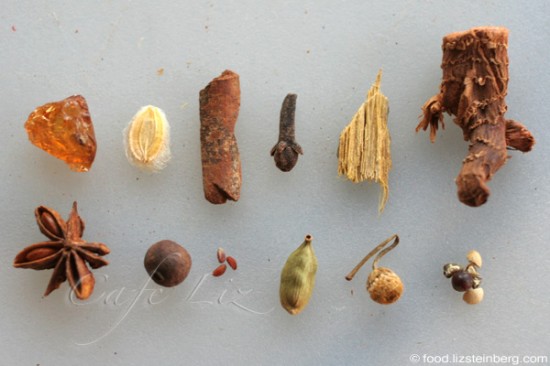
- Top row, from left: gum arabic, fuzzy cumin pods, cassia (cinnamon), cloves, licorice root, ginseng
- Bottom row: Star anise, allspice, some mustard-flavored seed, cardamom, platago/flavorless chamomile/something else, white and black pepper
The ras al-hanut:
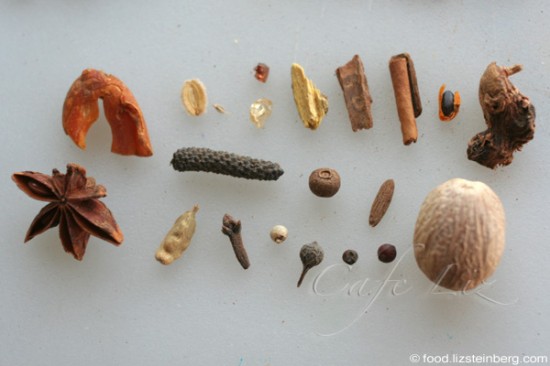
- Top row, from left: mace, fuzzy cumin thingy, anise, two kinds of gum arabic, licorice, cassia and cinnamon, some seed, ginseng
- Middle row:
Aleppolong pepper, allspice, some seed - Bottom row: Star anise, cardamom, cloves, white pepper, two black peppers, juniper, nutmeg (that’s 21 of 35)
Other potential suspects, based on things I’ve read: Dill seed (it resembles the fuzzy cumin), galangal, guinea grains, monk’s pepper (most likely the white pepper corns), platago (possibly the flower thingy), orris root, annatto, fennel seed, ajwain (a.k.a. caraway).
More:
A more practical ras al-hanut recipe.
Someone else who attempted to decipher his ras el-hanut.



